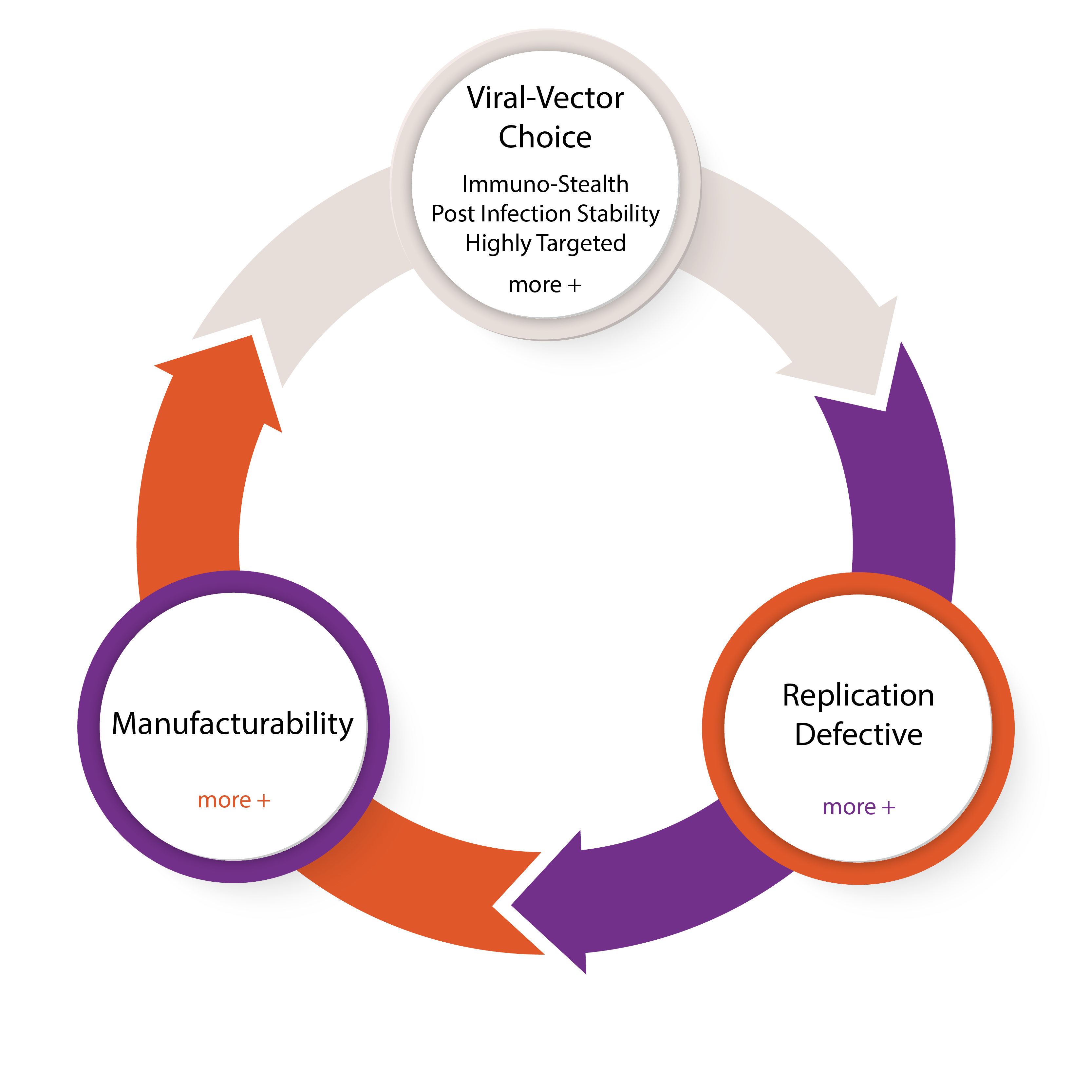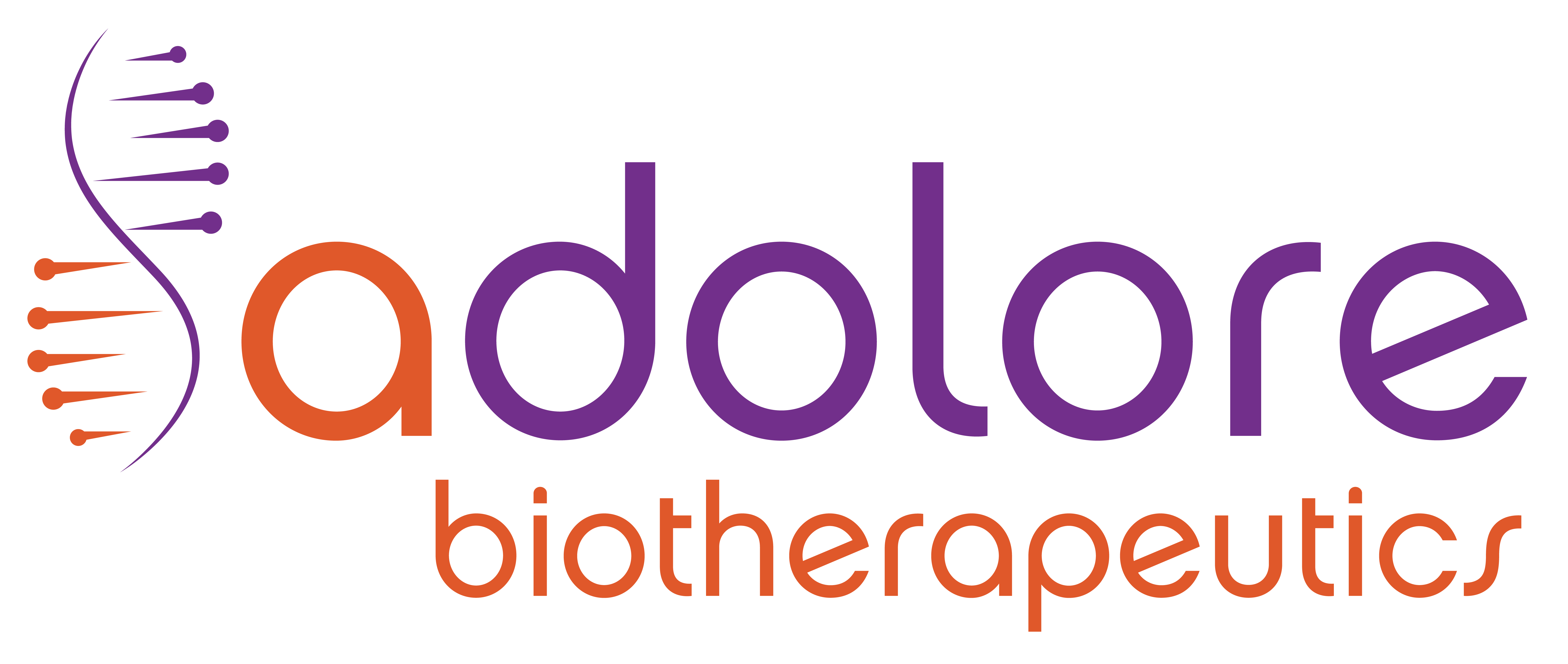Our Science
Revolutionizing Gene Therapy
Our Novel Vector Technology
Adolore BioTherapeutics, Inc., is revolutionizing the field of gene therapy by advancing and integrating the most innovative technologies in this field, thereby vastly increasing its versatility.
While most gene therapies to date focus on compensating or fixing broken genes in typically small (Orphan Drug) patient populations, we employ gene therapy as a tool to deliver novel protein therapeutics intracellularly that are highly efficacious. Our pharmacologic gene therapy approach (as opposed to corrective gene therapy) has the potential to reach large numbers of patients in many disease categories. Of course, in order to realize such mass-utility potential, it is essential that innovative gene therapies are highly efficacious and deliver excellent safety with minimal side-effects/off-target effects.
Based on the preclinical data, our gene therapy has the potential to address large-scale population needs to replace opioids. Our technology has resulted from numerous innovations to delivering a therapeutic peptide safely to the intracellular space. Our state-of-the-art gene therapy vector has been carefully bioengineered with precision to be ‘replication-defective’, making it disease-free. This gene therapy vector also evades immune detection, severe inactivating immune responses, and demonstrates tissue specificity traveling from local administration to where the pain signals are processed to produce profound analgesia without opioids.
By historic analogy, the innovation of humanizing antibody therapies has transformed the protein therapeutic space since 1990 from obscure niche therapies serving a few very unfortunate patients to mass-market applications like rheumatoid arthritis, psoriasis, cancer and numerous other diseases in large numbers of patients today. However, antibodies and other protein therapeutics have the fundamental limitation of working on the cell’s exterior and cannot penetrate cells to deliver the necessary treatment to intracellular targets.
There is a huge unmet need in medicine today to deliver therapeutic proteins inside the cell. In our opinion, the combination of our vector and therapeutic transgene-protein innovations represents this transformational therapeutic to advance our technology platform with the great potential to address significant unmet needs in medicine today by allowing novel protein therapeutics to be active inside target cells. Crossing this intracellular barrier has the potential, like antibodies did for the extracellular space, to be equally revolutionary for advancing an entire novel generation of intracellularly active protein pharmacotherapeutics for major inadequately addressed clinical needs, such as chronic pain.

Gene therapy itself is not new; it has been around for a few decades now – the first gene therapy, Gendicine (recombinant human p53 adenovirus), was approved in China in 2003. As with Gendicine, most first-generation gene therapies are delivered with viral vectors derived from the adenovirus, adeno-associated-virus (AAV) or retrovirus. Gene therapy delivery with these types of vectors is far from optimal, often causing severe immune responses (hyper-inflammatory immune responses or anaphylaxis or even a cytokine storm) and/or they can expose the patient to the risk of liver-injury and acute liver-failure (often lethal), or death.
While the genetics of first-generation gene therapy vectors are relatively easy to manipulate and have proven to be useful early research tools, they have not been optimally developed for pharmacotherapeutic applications and have many manufacturing and patient treatment disadvantages. Therefore, we have made very deliberate and targeted choices for, and thoroughly engineered modifications of, our carefully selected viral vectors and the associated cell-production system. Our innovative gene therapies have been developed in close collaboration with the world’s leading viral vector development lab of Dr. Joseph Gloriosio (Adolore Scientific Co-Founder and Chief Scientific Officer) and his team at the University of Pittsburgh, and are highly differentiated on the basis of the key aspects as indicated in the diagram above.
REPLICATION-DEFECTIVE: While it is efficient to start with a commonly used gene therapy viral vector, we were very careful to choose a vector that minimizes the risk of causing disease, infections or a cytokine storm. In order to achieve this, we have specifically engineered and “neutered” our HSV-vectors we employ, so that they cannot multiply on their own, or replicate and cause disease. This was accomplished by precisely removing our HSV-vector with all critical, immediate, early regulatory genes that are essential for viral replication. Thus, the vectors we use for our gene therapies are “replication-defective”, which we indicate with the notation “rdHSV.” We multiply (or grow) our vectors in specially genetically engineered proprietary cell lines that carry the functionality of these missing immediate early regulatory genes allowing our therapy to be manufactured.
Developing an rdHSV vector-based gene therapy lacking these critical regulatory genes, essentially eliminates the likelihood that natural recombination of our vector with any common highly prevalent HSV virus already in the majority of patient’s cells. This adds an additional safety factor for patients treated with our gene therapies.
MANUFACTURABILITY: Aside from the significant safety concerns, the high cost of manufacturing remains a significant obstacle for the large-scale adoption of gene therapies. For instance, the formation of (highly immunogenic) “empty capsids” resulting from producing AAV-based vectors, has forced companies to rely on complex small scale production processes to minimize this issue.
Our production approach is much simpler than required for first-generation gene therapies. Conceptually, we grow a sufficient cell mass at large scale, infect those cells with our viral vectors and propagate them within those specially equipped cells. In essence, this is similar to producing vaccines, e.g., flu vaccine, which are relatively inexpensive to make at a large scale. We believe that our future production costs will be competitive with other mass-market biotechnology medications.
